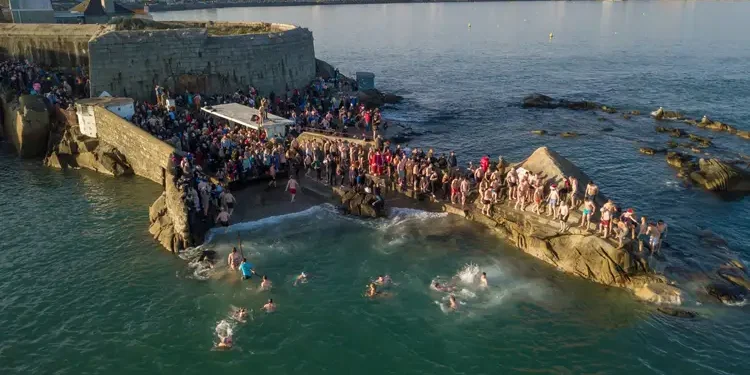By American standards, the holiday season starts early in Europe… Halloween isn’t traditionally celebrated here, and Thanksgiving doesn’t exist, so Europeans start thinking ahead to December in mid-October.
Big department stores begin to design gift displays and roll them out by Oct. 31, working ahead for the big day…
Across the Continent, Christmas markets often open in the first week of November and usually extend through the New Year, many featuring ice-skating rinks, fair rides, carnival games, and other festive pastimes…
Germany is the best country to visit when it comes to markets, as this is where they were born. Some have been held continuously since the 12th century.
At the same time, grocery store entries are taken over by towering displays of advent calendars of all kinds, some filled with chocolates, as we North Americans are used to, others filled with cookies, nougat, perfumes, candles, teas, toys, or beauty products…
By the end of the month, cities, towns, and villages of all sizes have laid the groundwork for Dec. 1, the day that the switches will be flipped and the festive
lights will be turned on…
They’ve dressed themselves up in strings of lights, garlands and greenery, erected elaborate decorations, stages, and trees that take over their streets and plazas.
While most of this may seem familiar, each country has its own particular tradition… from Norway’s “Teeny Tiny Christmas,” celebrated on Dec. 22, to Spain’s “pooping logs,” many are curious to us foreigners.
Some of my favorite countries to celebrate Christmas in Europe celebrate quite differently than we do in the States…
Start Your New Life Today, Overseas
Ireland
All over Europe, folks like to take a dip on Christmas day… from the Channel to the Mediterranean, a dip in your nearest body of water is one of the most traditional ways to celebrate Christmas day in Europe.
This came as a shock to when my family and I moved to Ireland 25 years ago—the Irish coasts are cold enough in summer, but during winter?
The Irish aren’t put off, though. From toddlers to retirees, you’re branded a chicken if you don’t at least splash your feet—and wetsuits are for the weak. Most run in and take a full plunge, running back out for whiskey or tea as soon as they’ve completed the mission.
We’d watch the bikini- and Speedo-clad crackpots from the shore, bundled in blankets on top of our coats… and still shivering.
The next day, Dec. 26, is St. Stephen’s Day and is traditionally known as Wren’s Day, colloquially, “The Wran.”
Back in the 1800s, a group of young lads would hunt a wren—believed to be evil—and tie its body to a holly branch before parading it around town. They’d go door to door asking for donations in honor of their kill, the proceeds used to fund a dance for the town.
Nowadays, the tradition has faded, and where it’s still celebrated no real birds are used, but the 26th continues to be a big social day in Ireland for friends to get together and share some goodwill… and the last of the holiday booze.
Spain
In Spain, Christmas traditions resembles that of Panama, where I lived for seven years.
The season here begins in earnest in November. By December, all the preparations have been made and not much work gets done until the second week of the New Year.
If you’re doing business in Spain, don’t come in December intending to get anything done. Administration is halted and all work is put on hold.
Most people take an extended vacation, but those who continue working through the month aren’t at their most productive.
Christmas Day is just the beginning of the festivities here, beginning the countdown to Epiphany, Jan. 6, the true celebration day—and Santa plays no part
in the holiday.
A big meal is typically had on Christmas Eve, before attending Midnight Mass, often called La Misa Del Gallo (Mass of the Rooster).
Dec. 28, Dia de los Santos Inocentes, is like April Fool’s Day—prepare for practical jokes and pranks.
On Jan. 5, parades called cabalgatas welcoming the Wise Men are held across the country, during which they throw out candies to spectators.
Traditionally in Spain, it’s the Wise Men bring the gifts—which makes sense, seeing as they were the first to bring gifts for Christmas. Kids write them letters
and leave out their shoes on the night of the 5th for the Kings to fill with goodies.
Finally, on the 6th, the Fiesta de Los Tres Reyes Magos (Celebration of the Three Wise Men), gifts left by the trio are opened.
The oddest of Spanish Christmas traditions has to be the “pooping log.” The Catalans’ version of yule logs is called Tió de Nadal (little Christmas log).
Caga Tió appears by the fireplace on Dec. 8, the Feast of the Immaculate Conception. He is fed, watered, and covered at night. On Christmas Eve he is
whacked like a piñata while the family sings until he “poops” some candy underneath his blanket.
The theme is carried through with a special character, ubiquitous in the Catalan nativity: the caganer, or pooping man. Back turned to the nativity scene, he’s
shown pulling down his pants, squatting, with a small “offering” underneath.
Caganers take on the form of celebrities these days—if you’ve been on TV or in a newspaper, you’ve probably been made into a caganer. Last year I bought my own in Barcelona, a statuette of Rodin’s “Thinking Man,” who’s already in the appropriate pose…
France
In France, where I currently live and have spent my last five Christmases, oysters are the star of the Christmas menu. From September on, they appear in every restaurant and market, on many street corners, and by Christmas Eve trucks of them block the streets. If not eaten on site, they are taken home and put on windowsills or balconies to be kept cold until it’s time to indulge.
Apparently, this dates back to King Henri IV, who couldn’t get enough of them. He had them brought to Paris by the cartload from Brittany every day, and the tradition stuck.
An even older kingly tradition here is the La Galette des Rois, which dates back to the 14th century. Traditionally eaten on New Year’s Eve, but also enjoyed throughout the season, this ubiquitous cake is a flaky circle of pastry filled with almond cream. In times gone by, a dried bean (une fève) was placed inside the cake and he who got the bean slice was king for the day.
The fève today has been replaced by all sorts of small toys or figurines, from tiny kings to cartoon characters, and the cake is always sold with a shiny gold cardboard crown, given to whomever gets the prize.
Portugal
Christmas in Portugal is all about the octopus, a delicacy and celebratory dish for all occasions. Through December, posters in grocery stores proclaim holiday greetings with pictures of cooked octopus.
Available fresh and frozen… Cooked, raw, cold hot… there’s no wrong way to do octopus here, but every part of the country has their preferred method.
In the Algarve, you dip the tentacles in boiling water three or four times to make them curl up before cooking, then marinate in wine or vinegar and steam or pressure cook them—don’t forget the wine cork thrown into the pot while cooking. Who knows what this is meant to do, but it’s tradition.
Bonne route,

Kat Kalashian
Editor, In Focus: Europe










